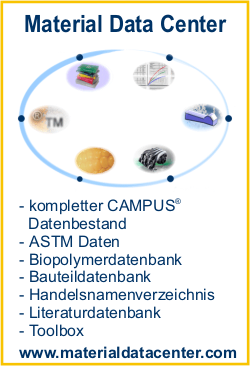
Alle Werkstoffdatenblätter sind frei verfügbar. Kostenlose Registrierung unter www.materialdatacenter.com
Material Data Center ist ein weltweit führendes Informationssystem für Kunststoffe und bietet eine umfangreiche Kunststoffdatenbank, Berechnungsprogramme, CAE Schnittstellen, eine Literaturdatenbank und eine Bauteildatenbank. Für mehr Informationen über Material Data Center besuchen Sie www.materialdatacenter.com.
Dies ist das kostenlose Material Data Center Datenblatt für CELCON® M90UV - POM - Celanese
Einheitenkonvertierung, PDF Datenblattdruck, direkter Vergleich mit anderen Kunststoffen, Schnapphakenberechnung, Biegebalkenberechnung, CAE Schnittstellen
Hier finden Sie eine Übersicht über weitere Informationen, die Material Data Center zu Celcon bietet.
| Verarbeitungs-/Physikal. Eigenschaften | Wert | Einheit | Prüfnorm | ||||||||||||||||||||||||||||||||||||||||||||||||||||||||||||||||||||||||||||||||||||||||||||||||
| ISO Daten | |||||||||||||||||||||||||||||||||||||||||||||||||||||||||||||||||||||||||||||||||||||||||||||||||||
| Schmelzevolumenrate, MVR | 8 | cm³/10min | ISO 1133 | ||||||||||||||||||||||||||||||||||||||||||||||||||||||||||||||||||||||||||||||||||||||||||||||||
| Temperatur | 190 | °C | - | ||||||||||||||||||||||||||||||||||||||||||||||||||||||||||||||||||||||||||||||||||||||||||||||||
| Belastung | 2.16 | kg | - | ||||||||||||||||||||||||||||||||||||||||||||||||||||||||||||||||||||||||||||||||||||||||||||||||
| Mechanische Eigenschaften | Wert | Einheit | Prüfnorm | ||||||||||||||||||||||||||||||||||||||||||||||||||||||||||||||||||||||||||||||||||||||||||||||||
| ISO Daten | |||||||||||||||||||||||||||||||||||||||||||||||||||||||||||||||||||||||||||||||||||||||||||||||||||
| Zug-Modul | 2600 | MPa | ISO 527 | ||||||||||||||||||||||||||||||||||||||||||||||||||||||||||||||||||||||||||||||||||||||||||||||||
| Streckspannung | 65 | MPa | ISO 527 | ||||||||||||||||||||||||||||||||||||||||||||||||||||||||||||||||||||||||||||||||||||||||||||||||
| Streckdehnung | 10 | % | ISO 527 | ||||||||||||||||||||||||||||||||||||||||||||||||||||||||||||||||||||||||||||||||||||||||||||||||
| Charpy-Kerbschlagzähigkeit, +23°C | 6.1 | kJ/m² | ISO 179/1eA | ||||||||||||||||||||||||||||||||||||||||||||||||||||||||||||||||||||||||||||||||||||||||||||||||
| Thermische Eigenschaften | Wert | Einheit | Prüfnorm | ||||||||||||||||||||||||||||||||||||||||||||||||||||||||||||||||||||||||||||||||||||||||||||||||
| ISO Daten | |||||||||||||||||||||||||||||||||||||||||||||||||||||||||||||||||||||||||||||||||||||||||||||||||||
| Schmelztemperatur, 10°C/min | 165 | °C | ISO 11357-1/-3 | ||||||||||||||||||||||||||||||||||||||||||||||||||||||||||||||||||||||||||||||||||||||||||||||||
| Formbeständigkeitstemperatur, 1.80 MPa | 101 | °C | ISO 75-1/-2 | ||||||||||||||||||||||||||||||||||||||||||||||||||||||||||||||||||||||||||||||||||||||||||||||||
| Längenausdehnungskoeffizient, parallel | 110 | E-6/K | ISO 11359-1/-2 | ||||||||||||||||||||||||||||||||||||||||||||||||||||||||||||||||||||||||||||||||||||||||||||||||
| Längenausdehnungskoeffizient, senkrecht | 120 | E-6/K | ISO 11359-1/-2 | ||||||||||||||||||||||||||||||||||||||||||||||||||||||||||||||||||||||||||||||||||||||||||||||||
| Andere Eigenschaften | Wert | Einheit | Prüfnorm |
| Wasseraufnahme | 0.75 | % | Ähnlich ISO 62 |
| Feuchtigkeitsaufnahme | 0.2 | % | Ähnlich ISO 62 |
| Dichte | 1410 | kg/m³ | ISO 1183 |
| Verarbeitungsempfehlungen Spritzguss | Wert | Einheit | Prüfnorm |
| Vortrocknung - Temperatur | 80 | °C | - |
| Vortrocknung - Zeit | 3 | h | - |
| Verarbeitungsfeuchte | ≤0.35 | % | - |
| Massetemperatur | 182 - 199 | °C | - |
| Werkzeugtemperatur | 82 - 93 | °C | - |
Standard reciprocating screw injection molding machines with a high compression screw (minimum 3:1 and preferably 4:1) and low back pressure (0.35 Mpa/50 PSI) are favored. Using a low compression screw (I.E. general purpose 2:1 compression ratio) can result in unmelted particles and poor melt homogeneity. Using a high back pressure to make up for a low compression ratio may lead to excessive shear heating and deterioration of the material.
Melt Temperature: Preferred range 182-199 C (360-390 F). Melt temperature should never exceed 230 C (450 F).
Mold Surface Temperature: Preferred range 82-93 C (180-200 F) especially with wall thickness less than 1.5 mm (0.060 in.). May require mold temperature as high as 120 C (250 F) to reproduce mold surface or to assure minimal molded in stress. Wall thickness greater than 3mm (1/8 in.) may use a cooler (65 C/150 F) mold surface temperature and wall thickness over 6mm (1/4 in.) may use a cold mold surface down to 25 C (80 F). In general, mold surface temperatures lower than 82 C (180 F) may hinder weld line formation and produce a hazy surface or a surface with flow lines, pits and other included defects that can hinder part performance.
Postprocessing conditioning and moisturizing are not required. It may be necessary to fixture large or complicated parts with varying wall thickness to prevent warpage while cooling to ambient temperature.
Material Data Center wird von M-Base Engineering + Software GmbH angeboten. M-Base Engineering + Software GmbH übernimmt keinerlei Gewährleistung, dass das System fehlerfrei ist. Jegliche Entscheidung über die Anwendung von Werkstoffen muss mit dem jeweiligen Produzenten einzeln abgeklärt werden.
Weiterführende Informationen zu diesem Material wie Stoffgruppe, Herstelleradresse, evtl. auch Datenblätter und Anwendungsbeispiele finden Sie auf www.materialdatacenter.com. Ein Teil der Informationen sind registrierten Nutzern vorbehalten. Auf der Startseite finden Sie einen Link zur kostenlosen Registrierung.












